President of the Royal College of Physicians of Ireland medal Abram Belskie
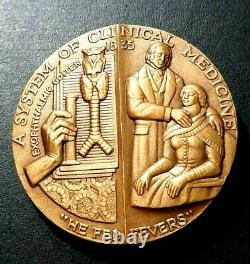
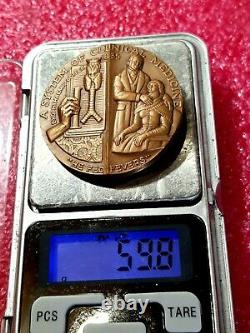
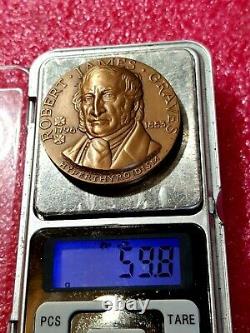
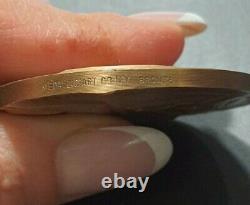
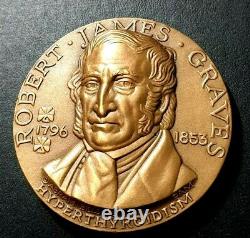

Abram Belskie (March 24, 1907 - November 7, 1988) was a British-born sculptor. He is known for his 1939 collaboration with Dr.
Robertson Dickinson on the Birth Series Sculptures. Belskie was born in London. And grew up in Glasgow. He graduated from the Glasgow School of Art. In 1929 he emigrated to New York.
USA, to work for British sculptor John Gregory. In 1938 Belskie was introduced to physician Robert Latou Dickinson. And subsequently applied his skills to create medical models, some of which were exhibited at the World's Fair of 1939. This was known as the Dickinson-Belskie Birth Series. In 1942, he created two sculptures, Norma and Normman, based on data collected by Dickinson, intended to represent the statistical ideal female and male figure.After Dickinson's death in 1950, Belskie instead created medallions (occasionally medicine-related). Belskie died in 1988 and, in 1993, the Belskie Museum of Arts and Science was opened in Closter, New Jersey.
It was founded by the Closter Lions Club. To preserve, house and exhibit the works of Abram Belskie. President of the Royal College of Physicians of Ireland.
Sir Henry Marsh, 1st Baronet. 27 March 1796 Holles Street, Dublin. 20 March 1853 (aged 56) Cloghan Castle, Co. (27 March 1796 - 20 March 1853) was an eminent Irish surgeon. He was President of the Royal College of Physicians of Ireland.
Fellow of the Royal Society of London. And the co-founder of the Dublin Journal of Medical Science. He is also the uncredited inventor of the second-hand on watches.
The eighth child of the Dean of Ardagh, Richard Graves. Of Dublin and Park, a member of one of the principal families of the King's County Offaly. , whose mother was the sister of Theaker Wilder. Wilder, Robert's father and maternal grandfather were all Senior Fellows of Trinity College, Dublin. Where in 1811 he was entered under his elder brother-in-law, Thomas Meredith.After receiving his early schooling in Downpatrick. After a brilliant undergraduate career in the arts, he received a degree in medicine in 1818 and left for London. To study surgery under Sir William Blizard. Afterwards, he spent the following three years travelling the continent.
Between stints as an observer at the medical schools of Edinburgh. Graves had an exceptional talent for languages, and while in continental Europe he was imprisoned for ten days in Austria. When travelling on foot without a passport; the authorities thought him to be a German spy. None of them believing that an Irishman could speak their language so well. Continuing his travels, in the Swiss Alps.
Graves became acquainted with the painter Joseph Mallord William Turner. They travelled and sketched together for several months, eventually parting company in Rome. On his way from Genoa. And the Park Street School of Medicine.
This included, among other things, bedsides teaching, of which William Hale White. Said "this is real clinical teaching", and went on in his book, Great Doctors of the Nineteenth Century, to say that Graves held the honour of introducing this system to Ireland. Mere walking the hospital must go. The Edinburgh system, in which the teacher interrogates the patient in a loud voice, the clerk repeats the patients' answer in a similar voice, the crowd of students round the bed, most of whom cannot see the patient, hears all this and makes notes, is of no use.Students must examine patients for themselves under the guidance of their teachers, they must make suggestions as to diagnosis, morbid anatomy and treatment to their teacher who will discuss the cases with them. In this technique one of his students, William Stokes. Together they made the Dublin School of Medicine.
Graves was possessed of the qualities that would ensure a great teacher. He was tall, somewhat swarthy with a vivacious manner, and like other avant-garde professors of his time, he gave his lectures in English rather than in Latin, or Dog Latin as was still the case in most classes in the 1830s. In his introductory lecture he said: "From the very commencement the student should set out to witness the progress and effects of sickness and ought to persevere in the daily observation of disease during the whole period of his studies". He was appointed Professor to the Institutes of medicine in the Irish College of Physicians and wrote essays and gave lectures on physiological topics. His "Clinical Lectures" were published in 1843 (and again in 1848), giving fame to his name throughout Europe.
He was president of the Royal College of Physicians of Ireland. In 1843 and 1844 and was elected a fellow of the Royal Society of London. He received honorary membership of the medical societies in Berlin, Vienna, Hamburg.
Among the innovations introduced in the lectures were the timing of the pulse by watch and the practicing of giving food and liquids to patients with fever instead of withholding nourishment. As well as the practical importance of bedside learning to ensure that a graduate was not "a practitioner who has never practised" he emphasised the importance of research, "learn the duty as well as taste the pleasure of original work". He corresponded with old pupils all over the world and continued as an inspired teacher until his death in 1853.In dealing with a colleague's attack on the use of the stethoscope. (the instrument was advocated by himself and Stokes having been invented in France in 1816), he wrote: "We suspect Dr Clutterbuck's sense of hearing must be injured: for him the'ear trumpet' magnifies but distorts sound, rendering it less distinct than before". In recognition of his achievements in education, Graves was named Regius professor of the Institute of Medicine in Trinity College. With William Stokes he edited the Dublin Journal of Medical and Chemical Science from 1832 to 1842, a journal he had founded with Sir Robert Kane. His lasting fame rests chiefly on his Clinical Lectures, which were a model for the day and recommended by none other than Armand Trousseau.
Cloghan Castle, the home of the Graves family from 1852 until 1908. She died after giving birth to a daughter, who died young. But she died with her daughter giving birth. In 1830 he married his third wife another relation of Graves' through the Dawsons of Dartrey. , Anna (died 1873), the eldest daughter of Rev. William Grogan of Slaney Park and Anne Saunders.By his third wife he was the father of six children, one of whom married Edward Blackburne of Rathfarnham Castle. The eldest son of Francis Blackburne.
His granddaughter, Georgina (Graves) Synge, was married to a first cousin of the playwright John Millington Synge. Cloghan Castle was left to his eldest son, Lt. Colonel William Grogan Graves, High Sheriff of King's County. Graves kept a townhouse on Merrion Square. But died of liver disease at his country residence, 20 March 1853, one week before his 57th birthday.
Which was near to his cousins, the Droughts, at Banagher. He was buried in Mount Jerome Cemetery. A collection of various of his papers, including a biography, was published by his friend and contemporary William Stokes.
As Studies in Physiology and Medicine, London, 1863. This item is in the category "Coins & Paper Money\Exonumia\Medals". The seller is "top-art-medals" and is located in this country: IL. This item can be shipped worldwide.

